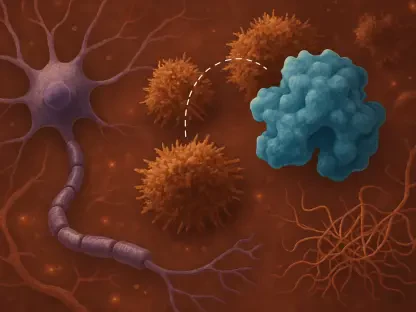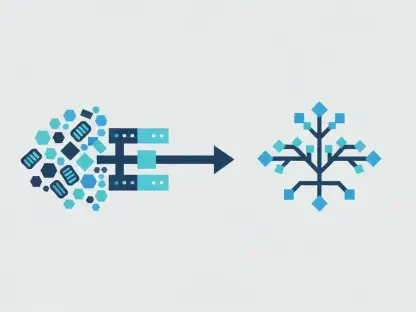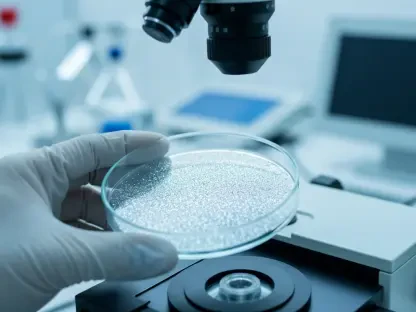Nanotechnology, already a powerful force in various industries, is now carving a defining role in medicine through advanced drug delivery systems. These systems employ nanoscale materials, unlocking unprecedented capabilities in targeting, efficiency, and personalization, marking a transformative leap in pharmaceutical science. Such intricate drug delivery mechanisms are taking center stage in healthcare, providing specific remedies with minimal adverse impacts, thereby answering longstanding challenges in chronic disease treatment. As the demand grows for precision medicine and responsive therapies, nanotechnology stands at the crossroads of innovation, promising profound changes for patients worldwide. This rapid advancement is backed by significant investments from stakeholders eager to harness its potential, with the global market projected to grow exponentially, signaling an era where healthcare becomes increasingly tailored and effective.
The Mechanics of Nanotech Drug Delivery
At the core of nanotechnology drug delivery systems are nanoscale carriers like liposomes, dendrimers, nanoparticles, and micelles, designed to enhance medicinal properties and effectiveness. These innovative materials facilitate optimum bioavailability and solubility, ensuring drugs reach the necessary areas at the cellular level while reducing possible side effects. As chronic diseases like cancer and neurological disorders continue to rise, so do endeavors to improve these systems for precise treatment and heightened efficacy. Emphasis on research in this space continues, leading to remarkable advancements supported by regulatory frameworks and technological innovations. The molecular complexity biotech specialists tackle daily is juxtaposed with the simplicity nanocarriers offer in therapeutic applications. This precision not only aids in treatment but also propels global market growth, proving nanotechnology’s integral role in reshaping modern medicine.
Nanocarriers’ ability to specifically target diseased cells epitomizes a breakthrough in overcoming traditional drug delivery challenges. The demand for site-specific controlled release systems has gained momentum, particularly in oncology where targeted therapies vastly improve patient outcomes by minimizing chemotherapy’s destructive impact. As artificial intelligence and machine learning become interwoven with nanotechnology, the development of nanocarriers witnesses advancements that allow predictive modeling of drug interactions, enhancing personalized treatment plans. Despite these strides, the market faces hurdles tied to research and development costs, complex regulatory landscapes, and scaling production techniques. Nevertheless, these challenges are met with innovative solutions and persistence in driving nanotech further into mainstream pharmaceutical applications.
Current Trends Shaping the Industry
Today’s nanomedicine landscape is vibrant with trends that significantly influence market evolution and application efficiency. Personalized medicine, tailoring drug delivery systems to patients’ genetic profiles, is gaining traction, optimizing therapeutic efficacy while minimizing side effects. This precision medicine trend is revolutionizing approaches; biotechnology firms are focused on creating patient-specific solutions. The shift toward biodegradable and biocompatible nanocarriers, crafted from materials like PLGA and lipids, highlights a growing safety concern while meeting regulatory standards. Another exciting frontier is the exploration of “smart” nanocarriers that adapt to environmental changes, offering highly controlled drug release. These trends collectively indicate a shift toward safer, more adaptive, and personalized drug delivery systems that significantly enhance patient care.
The sector’s transformation does not stop at improving personal therapies; it extends into broader healthcare enhancements. Particularly noteworthy is the convergence of nanotechnology with diagnostic imaging. This synergy paves the way for theragnostic platforms, merging diagnosis and treatment into a singular action with profound implications for early disease management, especially in cancer. Meanwhile, the commercial landscape sees burgeoning partnerships between pharmaceutical giants and nimble nanotech startups, aiming to innovate drug delivery solutions. Regulatory bodies play a central role, crafting pathways to ease market entry for these advanced therapies. These partnerships foster an environment ripe for innovation, ensuring nanotechnology’s steady integration into mainstream medical practices.
Opportunities and Challenges in Nanotech Drug Delivery
Despite the promising prospects, the nanotechnology drug delivery market grapples with notable challenges that demand strategic navigation. High R&D costs associated with sophisticated technological advancements often inhibit startups and smaller enterprises. Additionally, the complexity of scaling production and navigating intricate regulatory frameworks presents hurdles that require targeted solutions. Intellectual property and patent issues further complicate market entry, sometimes stifling new entrants. However, the landscape is not entirely forbidding; opportunities abound, especially for companies pioneering biologics and gene therapies. Stakeholders investing in combination therapies that simultaneously administer multiple drugs are particularly poised for success in the oncology sector, where synergistic effects are vital.
Strategic integration of digital health technologies with nanomedicine presents a promising avenue to improve treatment efficiency. Incorporating remote monitoring and data-driven adjustment systems into therapy plans can enhance patient care and outcomes dramatically. As enterprises align digital health advancements with nanotech innovations, the potential for a revolutionized healthcare experience becomes feasible. The nanotechnology drug delivery sector, while confronting significant hurdles, offers abundant room for growth and innovation, highlighting the need for continued investment in forward-thinking solutions.
Future Outlook and Market Expansion
Central to the advancement of drug delivery systems in nanotechnology are nanoscale carriers such as liposomes, dendrimers, nanoparticles, and micelles. These tiny structures are engineered to enhance the properties and effectiveness of medications, offering improved bioavailability and solubility. This ensures that drugs can reach the targeted cells effectively, minimizing potential side effects. As we see a rise in chronic diseases like cancer and neurological disorders, the focus on refining these systems for precise treatments continues to grow, leading to significant advancements. Ongoing research, backed by regulatory support and technological innovation, underscores the growing importance of nanotechnology in medicine.
The simplicity with which nanocarriers operate contrasts with the complex molecular challenges biotech experts face, significantly aiding therapeutic applications. This precision in targeting diseased cells marks a breakthrough, especially in oncology, by minimizing the harmful impact of traditional chemotherapy. The fusion of artificial intelligence with nanotechnology is propelling the development of sophisticated nanocarriers, paving the way for personalized medicine by enabling predictive modeling of drug interactions. While obstacles such as high research costs, regulatory hurdles, and production challenges exist, innovative solutions continue to push nanotechnology toward mainstream use in pharmaceuticals, marking a significant evolution in healthcare.









